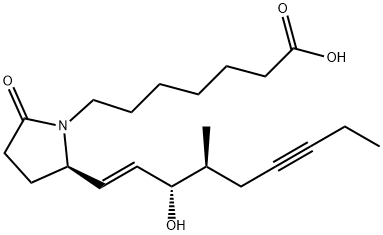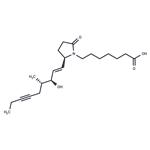The prostaglandin E receptor 4 (EP
4) is one of four G protein-
coupled receptors that mediate the actions of prostaglandin E
2 (PGE
2; ). Binding of PGE
2 to the EP
4 receptor causes an increase in intracellular cyclic AMP, which plays important roles in bone formation and resorption, cancer, and atherosclerosis.
1,2,3,4 KMN-
80 is a substituted γ-
lactam (pyrrolidinone) derivative of PGE
1 that acts as a selective and potent agonist of EP
4 with an IC
50 value of 3 nM (IC
50 = 1.4 μM for EP
3 and > 10 μM for all other prostanoid receptors).
5 In functional assays it has been shown to stimulate secreted alkaline phosphatase gene reporter activity in EP
4-
transfected HEK293 cells with an EC
50 value of 0.19 nM, demonstrating >5,000 and 50,000-
fold selectivity against EP
2 and TP, respectively.
5 KMN-
80 can induce the differentiation of bone marrow stem cells from both young and aged rats into osteoblasts
in vitro (EC
50s = 20 and 153 nM, respectively) and exhibits favorable tolerability up to at least 10 μM, whereas the EP
4 agonist L-
902,688 is highly cytotoxic at similar concentrations in these cells.
6 KMN-
80 has been used to repair calvarial defects in an
in vivo rat craniomaxillofacial reconstruction model (rate of reduction in defect size equivalent to BMP-
2 treated rats) and to promote bone formation in a rat incisor tooth socket model.
6
